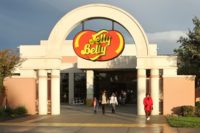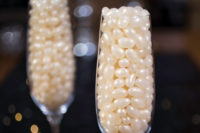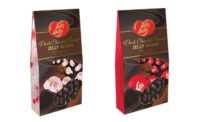Jelly Beans
The category will feel the impact of higher sugar prices, but vendors are keeping it interesting for consumers with a myriad of flavorful, fanciful value-added options.
Jelly Beans Estimated U.S. Retail Market Size
$220 million
Source: Confectioner estimate based on input from
industry players
Overview
The lowly jelly bean is far from lowly — and has
been exalted for some time, of course — at least since the 1980s when
the leader of the free world also happened to be a jelly bean aficionado!
The category splits between commodity and
premium/branded beans, and even includes some options that are considered
gourmet. Now the market is segmenting even further. Recent additions
include licensed jelly beans; jelly beans positioned for more
“mom-appeal” thanks to Vitamin C enrichment; jelly beans
enhanced with carbohydrates, vitamins and electrolytes and targeted to
athletes; and even delectable fruit flavor combos that duplicate the taste
of fruit juice smoothies. Sugar-free options expand the appeal to older
consumers who are more likely to be limiting sugar consumption.
Merchandising
In the non-bulk segment of the market, laydown bags
and peg bags account for the largest portion of sales, but single-serve
options are increasing too. In the gift segment, items priced at less than
$10 sell best.
Bulk display fixtures are a natural merchandising
vehicle for the vibrant hues of jelly beans. The basics of
“merchandising 101” apply: retailers need to keep bulk displays
clean, full and well labeled with prices and flavors. Gravity-feed
dispensers made of high-grade plastic are key to addressing
consumers’ expectations for safe, hygienic products.
Seasonal Opportunities
Despite the dominance of commodity beans at Easter,
keep in mind that jelly beans are Easter basket staples. Retailers with the
demographics to support it should consider tempting consumers to step
beyond their commodity bean “comfort zone” by featuring some
more upscale jelly bean offerings in in-store basket displays.
Outlook
Sales of sugar confectionery products have been flat
for the past couple of years, but things don’t have to stay that way.
The track record of premium chocolate suggests that gourmet jelly beans
have growth potential.
Sugar is a primary ingredient in jelly beans, so there
can be little doubt that the market will be affected by the surge in price
of domestic sugar this year courtesy of Hurricane Katrina and other
factors. Margins will be challenged, and retailers and consumers will
likely be faced with increased prices at Easter.
Top Flavors
Flavor authenticity is especially important in the
jelly bean category, with both the ever-popular fruity varieties and the
more fanciful renditions of taste experiences from other food and beverage
segments — everything from peanut butter to cappuccino. Here are the
top sellers from the category’s market leader: Very Cherry, Licorice,
Buttered Popcorn, Juicy Pear and Watermelon.



